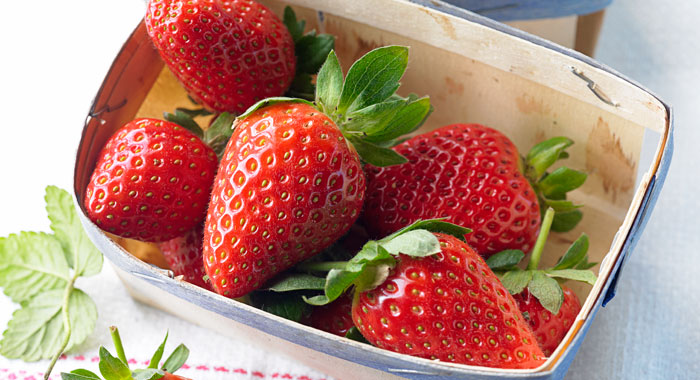
Pronounce it: straw-bare-ee
Once available in Britain for just a brief period during the summer, strawberries are now a year-round fruit, thanks to imports from warmer climates. However, the varieties grown for export tend to be chosen for their ability to withstand transportation, rather than for their texture or flavour, which often results in a less tender berry with an unremarkable taste. The fact that strawberries intended for export are picked before they’re properly ripe, means that their flavour is further impaired; strawberries don’t ripen after being picked.
To enjoy strawberries at their fragrant, juicy and flavourful best it’s worth holding out for the British season – if you want to eat them super-ripe, pick-your-own is best.
Read our guide on the health benefits of strawberry.
Availability
Imports are available all year round, but the British season runs from late May to early September. Strawberries are easy to grow in the garden or in a pot on a sunny windowsill – just remember to protect them from birds when the fruits appear!
Choose the best
Look for plump, shiny, tender berries, with a good, bright colour and a sweet aroma, preferably with their leafy green calyx and stalk still attached. Avoid mushy or mouldy berries.
If you’re buying a punnet, check that the underside isn’t stained – that means the lower level of berries has been crushed. Large strawberries tend to have a higher water content, so are less flavourful – go for small to medium-sized ones.
Elsanta is one of the most common strawberries available – it is sweet, but has a high water content, giving it a crisp texture. For flavour, sweetness and a softer texture, look for other British varieties, such as Ava, Florence, Alice and Rhapsody.
Also look out for the wild fraises des bois, from France. Small, with a conical shape, they have a wonderfully intense aroma and flavour.
Prepare it
Strawberries become mushy quite quickly on contact with water, so wash very briefly, hull (ie remove the calyx and stalk – on fully ripe strawberries this can be gently pulled out quite easily; otherwise it should be cut out with a small, sharp knife), then keep whole, half or quarter, as required.
Store it
Arrange strawberries on a layer of kitchen paper on a plate, so that they don’t crush each other, and store them in the fridge. Take them out of the fridge an hour before eating, so that they’re room temperature. Never wash before refrigerating them, as they’ll go soggy. Eat within a couple of days of buying or picking.
Cook it
Eat raw with cream or ice cream or sprinkled with a little balsamic vinegar. Add to fruit salads. Use to make jam, tarts or to top puddings.
Alternatives
Try raspberry.
Be the first to comment on "Strawberry"